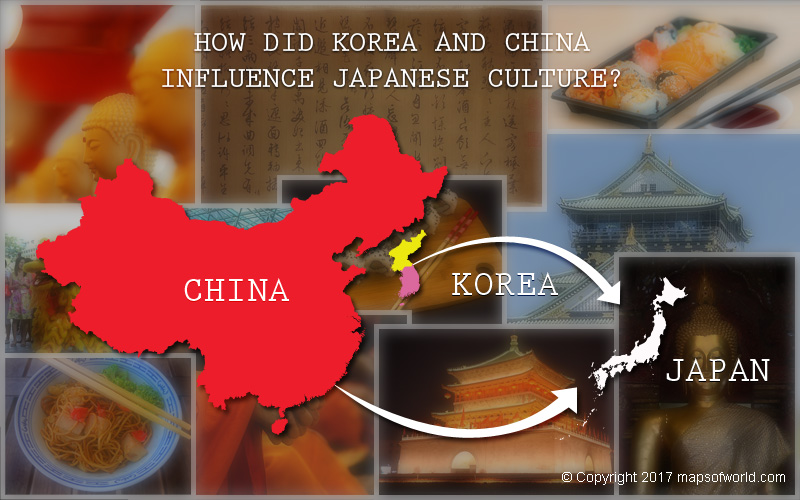

The Image Shows the Influence of China and Korea on Japan
No country in the world develops in isolation. All cultures develop and evolve due to the historic influences of neighboring states & kingdoms, adapting their religion, art, and social systems. Japan in East Asia is testimony to this fact. Classical Japan was greatly influenced by the Chinese script and social system. Buddhism too came to Japan from China. The initial contact between the two kingdoms came by way of Korean travelers and traders who arrived in Japan nearly 2,000 years ago. In fact, many aspects of both Japanese and Korean culture trace their origins back to imperial China. Let us take a deeper look at how China and Korea influenced Japanese culture.
Government – In the 7th century, Prince Shotoku Taishi sent his emissaries to study the Chinese court system and bureaucracy and promptly adopted titles, ranks, and systems similar to imperial China. The theory of Divine Origin of rulers also came in from China. This marked the entry of Confucianism into traditional Japanese thought.
Religion – As mentioned earlier, Buddhism came to Japan from China. There is a strong Buddhist following in the country. The native Shinto religion was steeped in nature worship and ancestral worship as well. Buddhism also deeply influenced Shinto rituals and practices.
Language – The history of both Korea and Japan from the 1st century AD can be found only in Chinese written records. This is because the Japanese did not have a written script. Both Japan and Korea adopted the written script from China and these later evolved to gain very distinct identities. Korea grew more to be like China and the Korean travelers to Japan brought the system of writing to Japan. Japan, China, and Korea fostered strong lines of communication due to this introduction.
Art and Culture – The development of architecture in cities such as Kyoto and Nara, particularly the construction of expansive temples and palaces, came in from China. Dance forms such as the Gigaku and Gagaku, music styles such as Kabuki were also deeply influenced by Chinese song and dance traditions. Arts in Japan similarly evolved due to the introduction of Buddhism and Buddhist literature.
While it becomes amply clear that China greatly influenced the art and culture of Japan, Korea became the conduit for such an influence. Imperial Korea too adopted much of Chinese culture but the systems were forced upon the Koreans by the royals. Koreans brought these practices to Japan who embraced them rather openly.
Related Maps:
The Republic of Madagascar is an island country located in the Indian Ocean, off the…
The Euro is the official currency of the European Union. It is, however, not incumbent…
There are many countries or regions that are partially recognized by the UN, have disputes…
The Alaska Statehood Act was signed into law by President Dwight D. Eisenhower in 1958,…
The name Persia may, however, only be used to refer to Iran in some contexts.…
Hawaii is an Island State in the US. It is one of the 50 states…